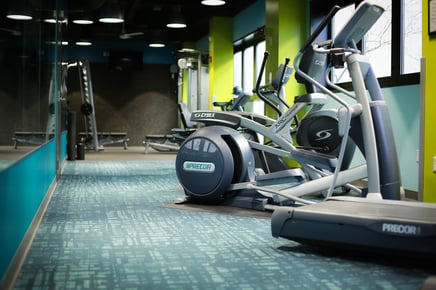 Corporate fitness programs in businesses all across the country have been doing pretty much the same thing, quite possibly for decades. The programs look very different, one from the next, but the basic premise is the same.
Corporate fitness programs in businesses all across the country have been doing pretty much the same thing, quite possibly for decades. The programs look very different, one from the next, but the basic premise is the same.
- Employer: "We want you to be healthy. Here's [insert your corporate fitness answer here: a gym membership, group fitness classes, walking paths, an onsite corporate fitness center, etc.] for you to use. Go be active (when you're not working).
- Employee: "I'd love to start exercising, but I don't know what's safest and most effective for me. Plus, I don't have much time, and clearly, I have work quotas to meet. It's great that the company offers these healthy options, but it doesn't seem like the right fit for me."
There's a real risk in corporate fitness that we only ever reach the folks who would be active regardless of whether there was a corporate fitness program. So the challenge for businesses becomes how to reach employees who are interested in exercising but who don't know where to begin. Get your organization started in the right direction with these three tips for improving your corporate fitness program.
Tip 1: Get the staffing right.
Finding the right staff to support your corporate fitness offerings is crucial to the success of the program. As an organization that provides this very service to businesses all over the country, we’ve written extensively on the topic. It’s no surprise that we think outsourcing your fitness staff is a great choice. However, if your fitness center staffing style is more of a DIY approach, definitely consider the tips in this blog, 3 Tips for Hiring an Active Aging or Corporate Fitness Professional.
Tip 2: Offer the right services.
There are core services that should be in place for a corporate fitness program to be successful:
- Individual education through exercise prescriptions and fitness assessment and testing is essential. Both of these services, which can easily be provided by your qualified staff, provide a fantastic foundation to the employees who are fence-sitters about exercise—you know, the employees who want to try moving more but who aren't sure how to get started safely. Those are the very same employees you're trying to draw into the program; addressing their concerns and questions with tailored services is a great way to show them that the door to starting an exercise program at work is wide open.
Alternative to Personal Training -- Read More!
- Incentive programs can help keep the fitness program interesting and are a fantastic way to help employees reach for better health beyond physical fitness. We've written about several of our successful incentives programs; click any of the titles below to find out more.
Employee Wellness Programming Beyond the Corporate Fitness Center
Making Fitness Fun in Corporate Wellness
Increasing Participation with SKELETONE
A Simple Way to Boost Participation in Your Corporate Fitness Center
How a Simple Squat Challenge Improved Corporate Fitness Metrics
Tip 3: Ask the right questions.
Anecdotal feedback and thank-you emails provide periodic indications of whether your fitness staff is on the right track with employees. But there's nothing like concrete bulk survey feedback to help steer a program in the right direction. Sure, there are problems with surveys, but in our decades of experience with managing corporate fitness centers, we increasingly find surveys to be a very helpful tool for setting our management strategy for each client. Here's how we use them:
- We use them for specific programs to determine whether we're achieving goals with those programs. For more on our evaluation methods, check out this blog: 4 Keys to Getting Wellness Program Data You Can Actually Use.
- From a program satisfaction standpoint, we've found surveys to be quite helpful as well. While the anonymity of them can sometimes leave our staff open to very negative feedback, the vast majority of responses are constructive and quite helpful for us in determining what our next year of program and service spotlights should be.
Want to learn more about how to make effective use of surveys to improve your corporate fitness program? Download our whitepaper.



 There are a variety of reasons for you, as a business owner, to set up a corporate fitness center for your employees; employee recruitment and retention are certainly among them. Increasingly, access to some form of
There are a variety of reasons for you, as a business owner, to set up a corporate fitness center for your employees; employee recruitment and retention are certainly among them. Increasingly, access to some form of 
 and activities for residents, I’m often surprised at what an afterthought their exercise amenities and services are. The clear appetite to provide residents with the very best options for living just doesn’t square with what’s in place for resident exercise at the community.
and activities for residents, I’m often surprised at what an afterthought their exercise amenities and services are. The clear appetite to provide residents with the very best options for living just doesn’t square with what’s in place for resident exercise at the community.